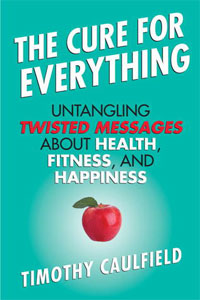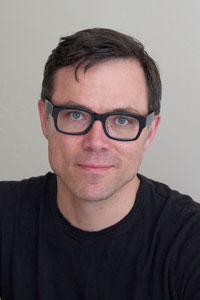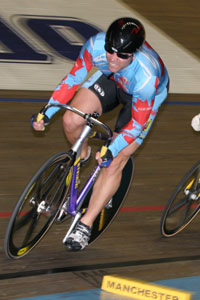For Timothy Caulfield, it wasn’t about vanity. It was about cutting through the twisted messages the diet and fitness industries sell our health-crazed society, and finally finding the best way to be truly healthy. And this is why instead of just writing about diet and fitness, he became a human guinea pig to test the theories and health advice he would propose in his book.
Caulfield, 48, is the research director of Health Law and Science Policy Group at the University of Alberta. And he’s now the author of “Finding the Cure to Everything: Untangling Twisted Messages about Health, Fitness and Happiness.” Unlike most authors who go the traditional route of research, deliberation and then writing, Caulfield became a walking experiment before he ever put pen to paper.
The project started as an academic book. “It wasn’t going to be for the popular press,” Caulfield told Diets in Review in a recent interview.” But then I started getting into it and thought, ‘I’m going to live every one of these chapters’ because I thought it would be a great story.”
Beyond the importance of academic accuracy, Caulfield found it essential to get a sense of what people are actually going through when it comes to their diet and exercise struggles. From his perspective, it’s easy to look at the literature and tell people what to do. But it’s far more challenging and meaningful to dive in and test the theories yourself.
“I’m a big believer in the study of lifestyle and whatever kind of change you make, you’ve got to be able to do it for life,” he said. “I wanted to know what it took to make it a lifestyle change. And you don’t get that just from looking at the data.”
So that’s exactly he did. Caulfield started to analyze every part of his diet and exercise routine to see where he was going wrong – turning his gaze inward instead of outward at everyone else. To get an accurate picture of how his body would change, Caulfield underwent a DEXA body scan to find out just how much body fat he really had.
 A DEXA scan is a low-level X-ray of your whole body that reveals a highly accurate picture of your body fat ratio. And much to his surprise, Caulfield found out he was carrying around a lot more fat than he thought he was, even though he wasn’t an ‘unhealthy’ person by any means.
A DEXA scan is a low-level X-ray of your whole body that reveals a highly accurate picture of your body fat ratio. And much to his surprise, Caulfield found out he was carrying around a lot more fat than he thought he was, even though he wasn’t an ‘unhealthy’ person by any means.
Seeing the results was an eye opening experience for the author who realized his estimations of his own health were way off. A life-long fitness junkie, Caulfield thought he was in great shape prior to the experiment’s commencement.
“I’ve always been a fitness junkie, working out sometimes two times a day, and despite that I was putting on weight.”
As a competitive track cyclist, Caulfield didn’t worry much about what he ate because he was ‘burning so many calories’ in the process. This intense activity allowed him to afford the extra calories, or so he thought. This is a common myth the author believes so many workout enthusiasts fall into.
But the truth was, his diet was a problem. Caulfield admitted he was eating a bag peanut M&Ms several times a week without much thought, and was just flat out consuming way too many calories. This habit of over-estimating his caloric needs was causing him to pack on weight – pound by pound, little by little, over the course of several years.
Diet Discoveries
In an effort to analyze where he was going wrong, Caulfield resorted to science. “I talked to experts all over the world, and I know what the data says about the diets,” he said. “A big theme in the book is ‘cut through the hype.’ We’ve known that for a long time. So for most of us, we just need to keep it very, very simple [with our diets].”
While some may see this as a letdown, leaving no ‘magic trick’ to weight loss after all, Caulfield found it freeing. “It’s liberating in a way because it tells us you can ignore all that bologna and make something work for you.” To do this, the author suggests first finding out how many calories you really need, then keeping a diet diary to track the calories you’re actually taking in.
This practice helped Caulfield realize he was eating mostly healthy, but just way too much. Recognizing his areas of weakness, the author now tries to avoid eating in front of the TV and keeps eating out to a minimum, admitting he’s only eaten a handful of entres at restaurants in the past three years.
Another diet tip he found to be true? Don’t drink your calories – they add up quickly and are totally unnecessary. Besides a little beer and an occasional skim latte, Caulfield sticks to water.
Fitness Breakthroughs
Caulfield stands behind the data that says you can’t use exercise alone as a weight loss tool. While there are many benefits of exercising, it’s merely correlated to weight maintenance, not weight loss. Caulfield experienced this himself as he reached his heaviest weight when he was at his most competitive in cycling.
He also firmly believes in the importance of resistance training until muscle fatigue, with proper form. “Don’t just work your biceps,” he said. “Work your whole system.” And in addition to that, practice interval training. “According to studies coming out of Canada, short bursts of intense intervals provide almost the exact same benefits as longer workouts.”
Another piece of advice: Don’t focus on aesthetics when trying to get fit like millions of Americans do. It’s not a sexy message, but it’s true, says Caulfield. Doing so will change your goals and ultimately become a distraction. Instead, focus on staying active and keeping your calorie count in check. These two things alone will go a lot farther than any diet, magic supplement or over-zealous workout program ever will.
The Results
While he didn’t expect major results in the beginning, Caulfield lost about 25 pounds in the first three months of the experiment and an additional five over the course of the two-year study – bringing his weight loss total to 30 pounds. And a second DEXA scan revealed that he didn’t lose any muscle mass – it was all fat. If somebody would’ve told Caulfield that he was carrying 30 pounds of fat prior to writing his book, he wouldn’t have believed it for a second.
Caulfield’s grand realizations from the book are this:
- There’s so much bologna out there. All of these supplements and colon cleanses and detoxes…we’ve been trying to find some magical diet for centuries. But sticking to the basics really works.
- Exercise shouldn’t be viewed as a weight loss tool, but rather a weight maintenance tool and a practice for health.
- Know how many calories you need and don’t exceed that: simple advice.
- Keep a diet diary. It’s very important, especially in the beginning of your diet change when you’re trying to assess exactly what you’re eating.
For anyone looking to get back to the basics and cut through any myths that may be keeping them from finding true health, “The Cure For Everything” may be the book for you. It’s now available online and from major booksellers nationwide.
Also Read:
